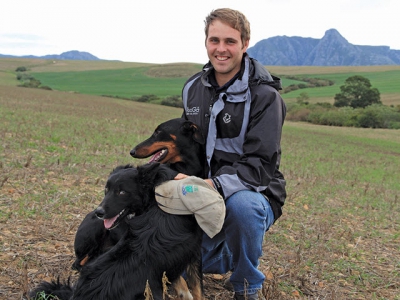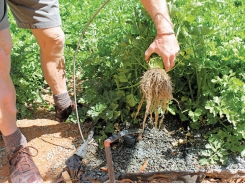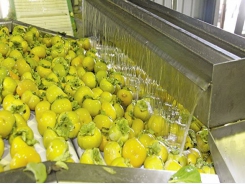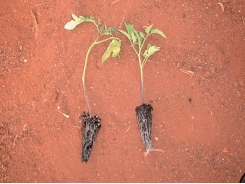Better soil with summer cover crops

Swellendam farmer Hoppies Uys has started a new farming trend in the Southern Cape by planting a summer cover crop directly after harvesting a silage crop in August. He talked to Glenneis Kriel about the principles involved and the results thus far.
Hoppies Uys with his dogs Eva and Amos. Hoppies farms with his father Pietie on Kliprivier near Swellendam in the Southern Cape. They farm Jersey cows, Nguni cattle and laying hens, and have about 560ha under cash crops and lucerne.
Planting a cover crop between two silage crops in a rotation system is not a new idea. Many farmers in the US and a few in KwaZulu-Natal are doing it, according to Hoppies Uys, who farms with his father Pietie Uys on the farm Kliprivier near Swellendam in the Southern Cape.
Hoppies put the rotation system into practice two years ago after reading widely on the subject and meeting Gabe Brown, one of the pioneers of conservation farming in the US, at an Acres USA Sustainable Agriculture Symposium in Columbus, Ohio. Brown used conservation farming methods incorporating rotation to improve his soil to the point where he required little fertiliser to produce a good crop.The main aim of this practice is to increase variety in rotation, thereby improving soil health.
“Incorporating as many different crops with as much variety in root systems as possible in a crop rotation system will improve the soil structure and create an environment in which soil organisms and plants can thrive,” Hoppies explains. Other benefits of this rotation system include an enhanced soil carbon level and improved soil water retention. It prevents a build-up of soil pathogens and diseases associated with monocropping; while a reduced rate of herbicide resistance development gives the farmer a wider selection of control methods. It also boosts fodder supply.
“We have 160 Jersey cows in milk, 426 Dohne Merino ewes, 300 layer hens and 30 Nguni cattle to feed. The farm has
560ha under crops. Of these, 15% are under lucerne and the rest are under cash crops such as wheat, canola, barley and oats. Incorporating a summer crop into the rotation means that we need to buy in less feed in November when there’s normally a shortage on the farm.”
Changing crop rotation patterns
At present, Hoppies’ crop rotation programme consists of five years of lucerne followed by five to six years of annual cash crops: oats, wheat, barley, canola, oats and wheat. To increase soil diversity, he is now moving to an entirely new rotation system.
Kliprivier is divided into seven different zones. Lucerne will be planted in only one of these zones for a five-to-six year cycle, after which the crop will be moved. This means that lucerne will be planted in the same zone only after 30 years. In the other zones, a rotation of three years’ forage crops will be followed by three years’ cash crops. This rotation will start in the first year with an oats cover crop grown for silage. Oats help to suppress diseases and improve soil health, and also produces substantial biomass, which helps to suppress weeds.
In the second year, Hoppies will plant either forage rye or grazing vetch; crops that also produce a great deal of biomass. The vetch is a legume which, through a symbiotic relationship with the bacteria rhizobium, binds nitrogen in the soil.
Pasture selection in the third year will depend on what is needed on the farm or in the soil.
During the grain phase of the rotation, wheat will be planted in the first year, canola or faba beans in the second year and wheat again in the third year.
Summer cover crops
A summer cover crop such as teff, sunflower or babala (a forage sorghum hybrid), will be planted after the oats are harvested. This will serve as a cover crop, says Hoppies, because its main goal is to cover the soil with plant material at a time when there is nothing on the land and to ultimately improve soil health. It does not serve to produce feed or generate an extra income; it is simply a spin-off from planting the cover crops.
Until recently, Hoppies had planted a summer cover crop in early October after harvesting oats, as planting it after harvesting wheat or canola towards November, by which time it would be too dry to plant, would not produce good results.
“A summer cover crop needs moisture for a good start, but once it gets going, it requires few inputs,” explains Hoppies.
When selecting a summer cover crop, he studies cost and availability. “I look for the cheapest cultivars suitable to my conditions as its purpose is to improve soil health by increasing variation in the soil, not to produce a premium-quality crop,” he says.
So far he has planted teff, sunflower, babala and sunn hemp as monocrops or as mixtures for a cover crop. Teff produces substantial amounts of fine plant material and in effect creates a good mulch. Sunflowers have a strong taproot that helps to loosen soil and reduce compaction, as well as allopathic properties that reduce soil diseases. Babala has good nutritional value as dairy feed, while sunn hemp is a legume that accumulates quantities of dry matter and fixes nitrogen.
Herbicide sprayed before planting reduces competition from weeds. No herbicide is needed during production, as the biomass created by these crops suppresses weed growth. To keep costs down, Hoppies does not apply fertiliser.
Termination
Cows graze the forage crops down to a third of their yield in November, about sixty days after establishment. The risk of compaction is small, as the animals move swiftly through the camps as did the herds of springbok through this area many years ago. The large volume of biomaterial on and below the soil surface serves to reduce compaction, explains Hoppies.
“They can graze off more material, as most of it rots away before I plant the new crop. The roots in the soil are more important to me,” he says. Crop growth is terminated at its most vulnerable – about 90 days after planting – mostly by herbicide spraying in mid-January, and left on the soil as mulch. Sunflower is simply rolled flat because it produces so much biomass that it does not naturally lie flat.
Results so far
Hoppies has experimented with this practice for two seasons: on 70ha last year and 160ha this year. It is still too early to see the impact on the soil, but the practice has boosted farm income and has supplied additional pasture to 75 cows for a month. So far, no negative impact on the production of follow-up crops has been recorded.
This year, it generated R918,85/ha in a 11ha camp planted to a babala-sunflower mixture. A mixture of sunn hemp and babala generated an income of R2 727,06/ ha in a 14ha camp and R1 864,52/ha in a 16,3ha camp. Sunn hemp as a monoculture resulted in a loss of R1 468,15/ ha as it is not a suitable animal forage (see table).
With the Southern Cape being very dry, Hoppies is keen to see how the crops will perform. His advice to farmers wanting to incorporate summer crops into their rotation is to plant when the soil is moist enough to give the crop a good start and save costs. Teff is the cheapest.
“Experiment with it first on a smaller area to see if it works and then make it part of your rotation,” he says.
Related news
Tools

Phối trộn thức ăn chăn nuôi

Pha dung dịch thủy canh

Định mức cho tôm ăn

Phối trộn phân bón NPK

Xác định tỷ lệ tôm sống

Chuyển đổi đơn vị phân bón

Xác định công suất sục khí

Chuyển đổi đơn vị tôm

Tính diện tích nhà kính

Tính thể tích ao




 Growing apples in the Malutis
Growing apples in the Malutis  Seedlings: Balancing fertility & hardening
Seedlings: Balancing fertility & hardening